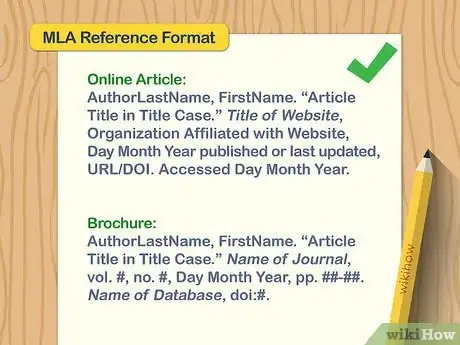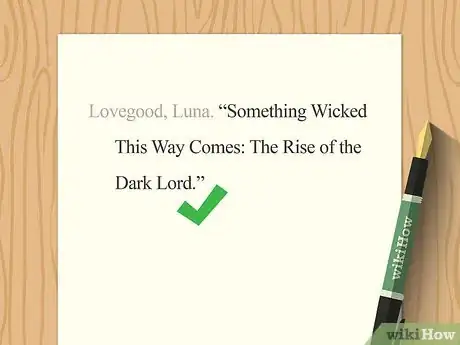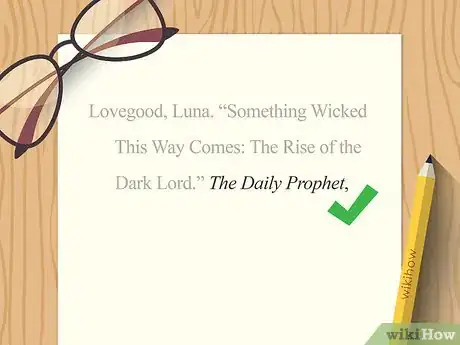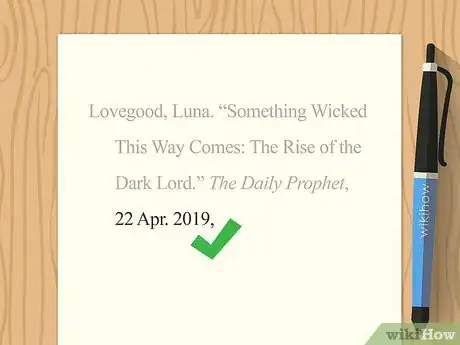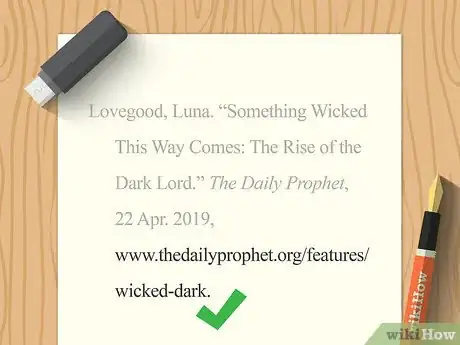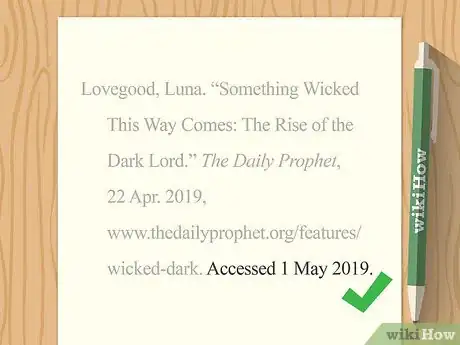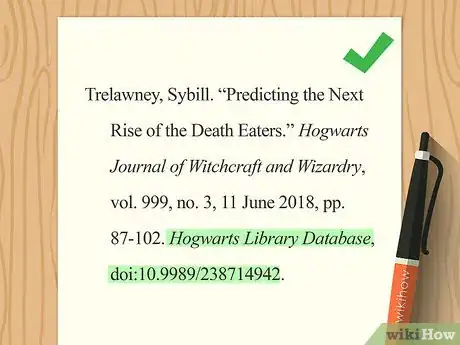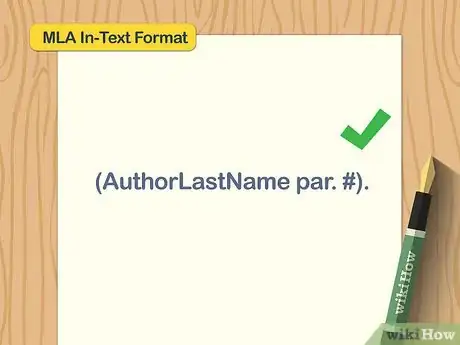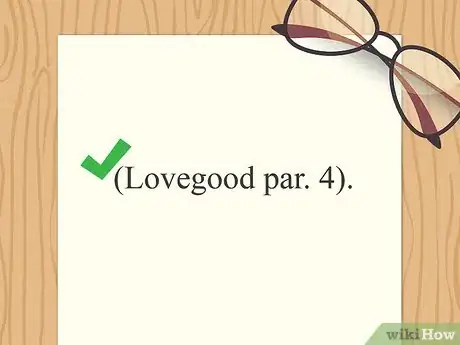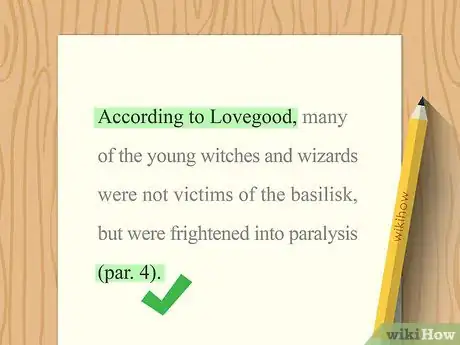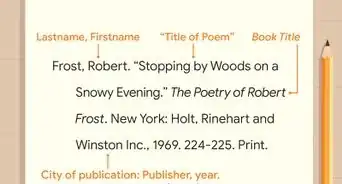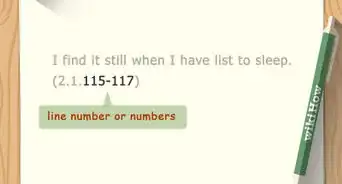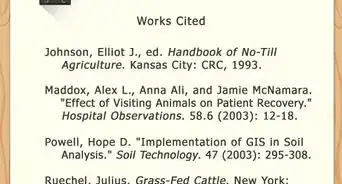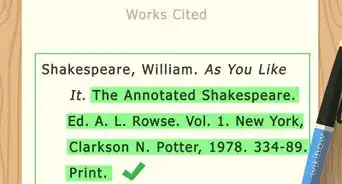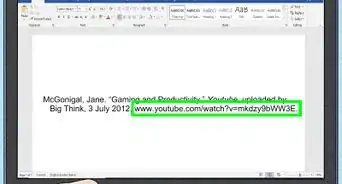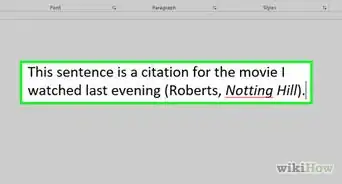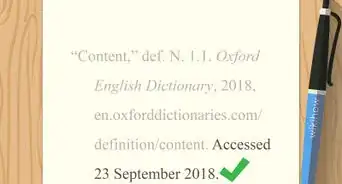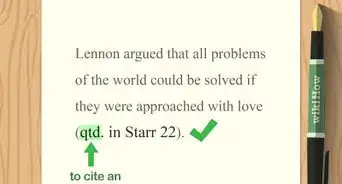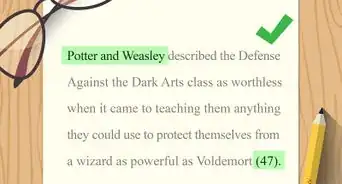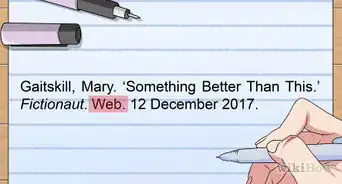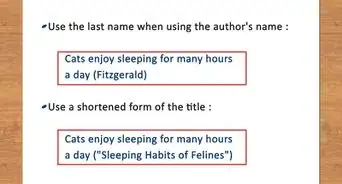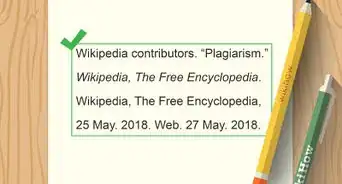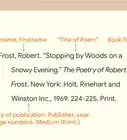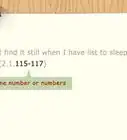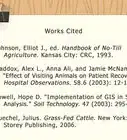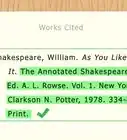This article was co-authored by wikiHow staff writer, Jennifer Mueller, JD. Jennifer Mueller is a wikiHow Content Creator. She specializes in reviewing, fact-checking, and evaluating wikiHow's content to ensure thoroughness and accuracy. Jennifer holds a JD from Indiana University Maurer School of Law in 2006.
This article has been viewed 43,906 times.
Learn more...
When you're researching to write a paper, a lot of your sources will likely come from the internet, including articles from newspapers, magazines, or scholarly journals. The Modern Language Association (MLA) citation style guidelines require you to cite online articles differently than you would cite print articles. Even if the article you found online also exists in print, your Works Cited entry should take your reader to the version of the article that you accessed. Generally, this means including a URL or DOI (Digital Object Identifier) in your entry.[1]
Steps
Works Cited Entry
-
1Start your Works Cited entry with the name of the author or authors. Type the author's last name first, followed by a comma. Then type their first name. Place a period after the author's first name.[2]
- Example: Lovegood, Luna.
- If there are 2 authors, type the word "and," then type the second author's name in first name-last name format. If there are 3 or more authors, simply type the first author's name followed by the abbreviation "et al."
Exception: If the name of the website where the article is located and the name of the author are the same, as with a corporate or institutional author, skip the author and start your Works Cited entry with the title of the article.
-
2Provide the title of the article in double quotation marks. Type the title of the article in title case, capitalizing the first word and all nouns, pronouns, adjectives, adverbs, and verbs. If there is a subtitle, place a colon at the end of the title and then type the subtitle in title case. Place a period at the end, inside the closing quotation marks.[3]
- Example: Lovegood, Luna. "Something Wicked This Way Comes: The Rise of the Dark Lord."
Advertisement -
3List the name of the website and affiliated organization. After the title, type the name of the website in italics, followed by a comma. Then list the name of the affiliated organization in regular font. If the name of the website and the affiliated organization are the same, include only the title of the website. Place a comma at the end.[4]
- Example: Lovegood, Luna. "Something Wicked This Way Comes: The Rise of the Dark Lord." The Daily Prophet,
-
4Include the date of publication. After the comma, list the date the article was published or last updated or modified. Use the most specific date available. List the day first, followed by the month, then the year. Abbreviate the names of months with more than 4 letters. Place a comma after the year.[5]
- Example: Lovegood, Luna. "Something Wicked This Way Comes: The Rise of the Dark Lord." The Daily Prophet, 22 Apr. 2019,
-
5Add the direct URL for the article. After the date, provide the direct URL or permalink for the article. Leave off the "http://" portion of the URL. Place a period at the end.[6]
- Example: Lovegood, Luna. "Something Wicked This Way Comes: The Rise of the Dark Lord." The Daily Prophet, 22 Apr. 2019, www.thedailyprophet.org/features/wicked-dark.
-
6Close with the access date if required. The date of access is optional in the 8th edition of the MLA. However, it's recommended if there is no publication date for the article. Even if there is a publication date, your instructor still may want you to include it. If you include the access date, type the word "Accessed" followed by the date in day-month-year format. Abbreviate all months with more than 4 letters. Place a period at the end of the date.[7]
- Example: Lovegood, Luna. "Something Wicked This Way Comes: The Rise of the Dark Lord." The Daily Prophet, 22 Apr. 2019, www.thedailyprophet.org/features/wicked-dark. Accessed 1 May 2019.
MLA Works Cited Entry Format – Online Article
AuthorLastName, FirstName. "Title of Article in Title Case." Title of Website, Organization Affiliated with Website, Day Month Year published or last updated, URL/DOI. Accessed Day Month Year.
-
7Use a DOI for scholarly journal articles found on online databases. Under the 8th edition of MLA, if you access a scholarly journal article online and it has a DOI, you should use that instead of a URL. DOIs are permanent, while URLs may change. Use the same format you would use for a scholarly journal in print, then add the DOI at the end. You shouldn't ever need an access date for a DOI since they are permanent.[8]
- Example: Trelawney, Sybill. "Predicting the Next Rise of the Death Eaters." Hogwarts Journal of Witchcraft and Wizardry, vol. 999, no. 3, 11 June 2018, pp. 87-102. Hogwarts Library Database, doi:10.9989/238714942.
MLA Works Cited Entry Format – Online Scholarly Journal Article
AuthorLastName, FirstName. "Article Title in Title Case." Name of Journal, vol. #, no. #, Day Month Year, pp. ##-##. Name of Database, doi:10.0000/000000000.
In-Text Citation
-
1Include the author's last name in your parenthetical citation. MLA style for in-text citation doesn't vary if you're citing an article that you found online, rather than in print. Start your parenthetical citation with the author's last name. If there are 2 authors, list them both connected by the word "and." If there are 3 or more authors, use the first author's last name followed by the abbreviation "et al."[9]
- Example: (Lovegood
-
2Use paragraph numbers if no page numbers are available. A parenthetical citation includes the author's last name and the page where the information you paraphrased or quoted appears. With online scholarly journal articles, you'll typically have page numbers. However, if the article is published directly to a website, page numbers may not be available. Count the paragraphs and use that number instead along with the abbreviation "par." or "pars." Place the sentence's closing punctuation outside the closing parenthesis.[10]
- Example: (Lovegood par. 4).
MLA In-Text Citation Format
(AuthorLastName par. #).
-
3Incorporate the author's name into the text of your paper. If you use the author's name in the text of your paper, there's no need to type it again in your parenthetical citation. The only information you'll need in your parenthetical citation is the page or paragraph where the quoted or paraphrased material can be found.[11]
- For example, you might write "According to Lovegood, many of the young witches and wizards were not victims of the basilisk, but were frightened into paralysis (par. 4)."
References
- ↑ https://owl.purdue.edu/owl/research_and_citation/mla_style/mla_formatting_and_style_guide/mla_works_cited_electronic_sources.html
- ↑ https://libguides.libraries.wsu.edu/c.php?g=754510&p=5407117
- ↑ https://libguides.libraries.wsu.edu/c.php?g=754510&p=5407117
- ↑ https://libguides.libraries.wsu.edu/c.php?g=754510&p=5407117
- ↑ https://libguides.up.edu/mla/common/journal_articles
- ↑ https://libguides.up.edu/mla/common/newspaper_articles
- ↑ https://libguides.up.edu/mla/common/newspaper_articles
- ↑ https://libguides.up.edu/mla/common/journal_articles
- ↑ https://columbiacollege-ca.libguides.com/MLA9/newspapers
- ↑ https://owl.purdue.edu/owl/research_and_citation/mla_style/mla_formatting_and_style_guide/mla_works_cited_electronic_sources.html
- ↑ https://owl.purdue.edu/owl/research_and_citation/mla_style/mla_formatting_and_style_guide/mla_in_text_citations_the_basics.html
- ↑ https://owl.purdue.edu/owl/research_and_citation/mla_style/mla_formatting_and_style_guide/mla_works_cited_electronic_sources.html
